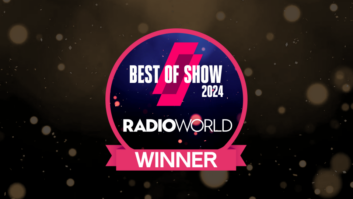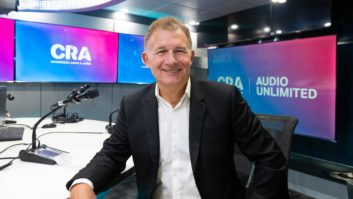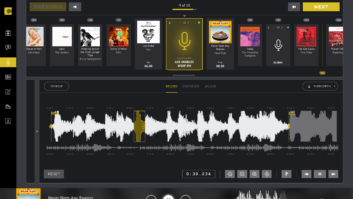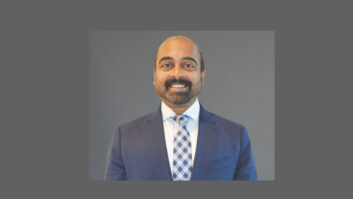Audacy is in the process of rolling out the new HLS+ streaming technology from Super Hi-Fi on its 700 or so online stations, as we reported earlier this week. The change means listeners to those streams who use compatible devices will be able to enjoy new interactive and personalization features.
Super Hi-Fi calls HLS+ transformative. I interviewed CEO Zack Zalon to ask him to explain the technology and why he’s excited about it.
Radio World: Help us understand what HLS+ is and why you’re excited about it.

Zack Zalon: Let’s start by considering what does radio does incredibly well: production, branding, segues with sound effects or sweepers, and personalities who narrate an experience and pull people through a journey.
But over the past decade the digital ecosystem has become more about interactivity and personalization. Look at Spotify. The ability to skip songs and go right to the beginning of the next one, the ability to get personalized information flown in for you, are great. But then you don’t get production, you don’t get narration, you don’t get branding elements — nothing that makes radio amazing.
What we’ve been working on for three years is an entirely new streaming technology to allow both true linear, fully produced, live radio experiences, the full complement of radio’s capabilities, plus full interactivity and personalization.
Let’s say you’re listening to a song and there’s a segue that’s about to happen. In that segue, you’ll get a branding element, a voice track, another branding element and another song, all stitched together perfectly, just as you’d expect on the world’s best broadcast radio experiences. And if you listen to it with HLS+, that’s what you’ll hear. But if you skip, you will go to the beginning of the next song perfectly, with no production overhangs, just like you would on a Spotify or an Apple Music. It won’t skip to a random spot on the stream; it won’t leave some of that production overhang audible.
It’s almost as though HLS+ is crafting an entirely new experience for you on the fly, which makes it feel like just an interactive music service, but still with the production capabilities of radio on top of it.
That’s the first part. The second part is personalization. So let’s say a sports report comes up in a radio broadcast stream. You’re in Washington, Paul, so with HLS+, you’ll get a Washington Capitals report, but I’ll get an L.A. Lakers report — at the same time, in the same spot on the stream — and then we go back into regularly scheduled programming. It’s seamless.
This combination of capabilities has never existed before. That stream theoretically could power a broadcast radio experience through the FM or HD Radio dial too; but when you receive it on an interactive player on your phone, all that interactivity comes to life. And it’s the same stream, which can be both live and fully produced as well as interactive and personalized, all at the same time.
Finally, if the stream connects to a player that doesn’t support that interactivity, it folds down automatically into a traditional HLS stream — meaning this technology is compatible with billions of devices that already exist, such as Amazon Alexa, Sonos, etc.
Audacy is converting all 700 of its online-only exclusive stations into HLS+ by the end of the month. And we’re going live with industry support from Telos Alliance, Orban, Barix, Xperi and its AIM app platform, and more coming.
The industry has needed an advanced technology to allow them to keep the production that makes radio great, but also to take advantage of real interactivity, as Spotify, Apple Music and Amazon Music have had for years. We have heard from countless radio companies that they’re frustrated by limits of their existing streaming tech. So this is a unique opportunity for radio companies.
RW: Where will this show up?
Zalon: For starters, if a consumer is using the Audacy app, all those stations soon will work in a fully produced and fully interactive way. We’re going live with them on all of their apps for iOS, Android and web via JavaScript. We’ve also tested it on Alexa devices and believe that our ecosystem will soon include Amazon Alexa, even for the fully interactive experiences. And we’ll announce more customers over coming months.
RW: What does a streaming company need to do on the infrastructure side to integrate this?
Zalon: They have to be using the Super Hi-Fi operating system, which we call Program Director. It’s part of that ecosystem; but there’s no upcharge for using HLS+. It’s a small amount of code added to a customer’s player ecosystem. To date, if you use Program Director and want to do a stream, you can select HTTP streaming, you can select standard HLS or you can select RTMP. Now you’ll also be able to select HLS+ and the stream it creates is designed for that environment, it will provide that production, interactivity and personalization.
RW: To be clear, this discussion applies to online streaming audio stations, not over-the-air.
Zalon: Well, if one of our customers is using Program Director to power an HD Radio or FM broadcast, that same experience would instantly be available as an interactive version online. Again, it’s a single stream. If it plays on FM, it obviously won’t be interactive, but if you listen in your interactive player, it is. We think this opens up a world of cool digital use cases.
RW: You mentioned skipping ahead. What happens when there’s a live, real-time element in the audio?
Zalon: It will collapse to live, and you can’t skip forward anymore until the live experience is over, say with a morning show. But the minute that show goes back to prescheduled voice-track programming, you’re right back in the interactive experience again.
This is amongst the most complicated technologies we’ve built. But it’s necessary, especially if radio is going to stay attractive to the next generation of consumers.
One of the things radio is not doing very well is bringing in younger listeners. Those users are accustomed to controlling their own experiences, and radio has never been about user control. HLS+ starts to layer some of that control directly on top of the radio stream itself, so a younger demographic is more likely to experience radio in a similar manner to how they’re interacting with all of their other media sources. Our goal is to use HLS+ to make radio as relevant as possible to the broadest possible audience of listeners.
RW: You listed several technology partners that are supporting this. In what way are they doing so?
Zalon: Embedding the ability to read HLS+ into their devices would be one example. But more broadly these companies share a vision for transformation across the entire radio landscape. They see that we need a collective ecosystem of interoperable tools to help carry radio into the next generation of listeners. So while they’re supporting HLS+, you’ll see us supporting some of their advanced technologies as they come to market over the coming years.
RW: Are those companies licensing HLS+ from you?
Zalon: No. We’re working together on a range of ways HLS+ might manifest itself in the industry. Right now it’s most useful for online digital radio. But there are so many technologies that are advancing the longer-term opportunity for radio companies, from entirely new studio and playout tools to in-car interactive entertainment services. We believe that HLS+ will add meaningful value across a variety of touchpoints on that ecosystem, and we’re incredibly excited to demonstrate some of those options as things unfold over time.












